Strategic Analysis: PESTEL & Porter's 5 Forces on Banyan Tree
VerifiedAdded on 2023/05/30
|12
|2980
|283
Report
AI Summary
This report provides a strategic analysis of Banyan Tree Holdings Limited, a global hospitality organization, using PESTEL and Porter's Five Forces frameworks. The PESTEL analysis examines political, economic, social, technological, environmental, and legal factors impacting Banyan Tree's operations, particularly in China and Singapore. The Porter's Five Forces analysis assesses the competitive intensity, threat of new entrants, power of suppliers and buyers, and the threat of substitutes within the hospitality industry. The report identifies challenges such as increasing competition from online accommodation platforms and suggests strategic recommendations for Banyan Tree to enhance its market presence, including expansion into emerging markets like India, strategic alliances, and the introduction of new, locally-infused services to increase revenue and customer loyalty. The analysis concludes that while Banyan Tree operates profitably, increasing competition requires strategic adaptation for continued success.
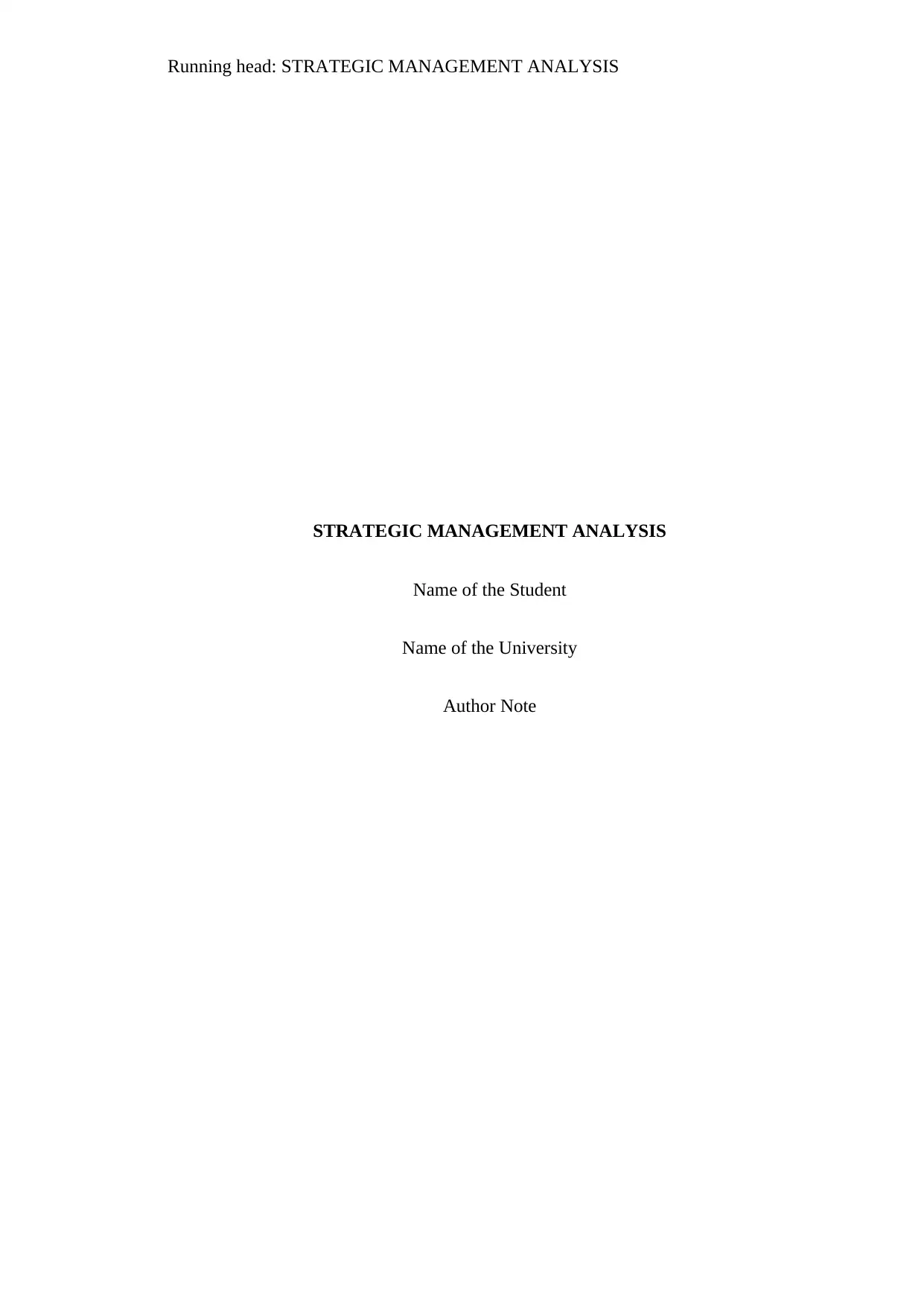
Running head: STRATEGIC MANAGEMENT ANALYSIS
STRATEGIC MANAGEMENT ANALYSIS
Name of the Student
Name of the University
Author Note
STRATEGIC MANAGEMENT ANALYSIS
Name of the Student
Name of the University
Author Note
Paraphrase This Document
Need a fresh take? Get an instant paraphrase of this document with our AI Paraphraser
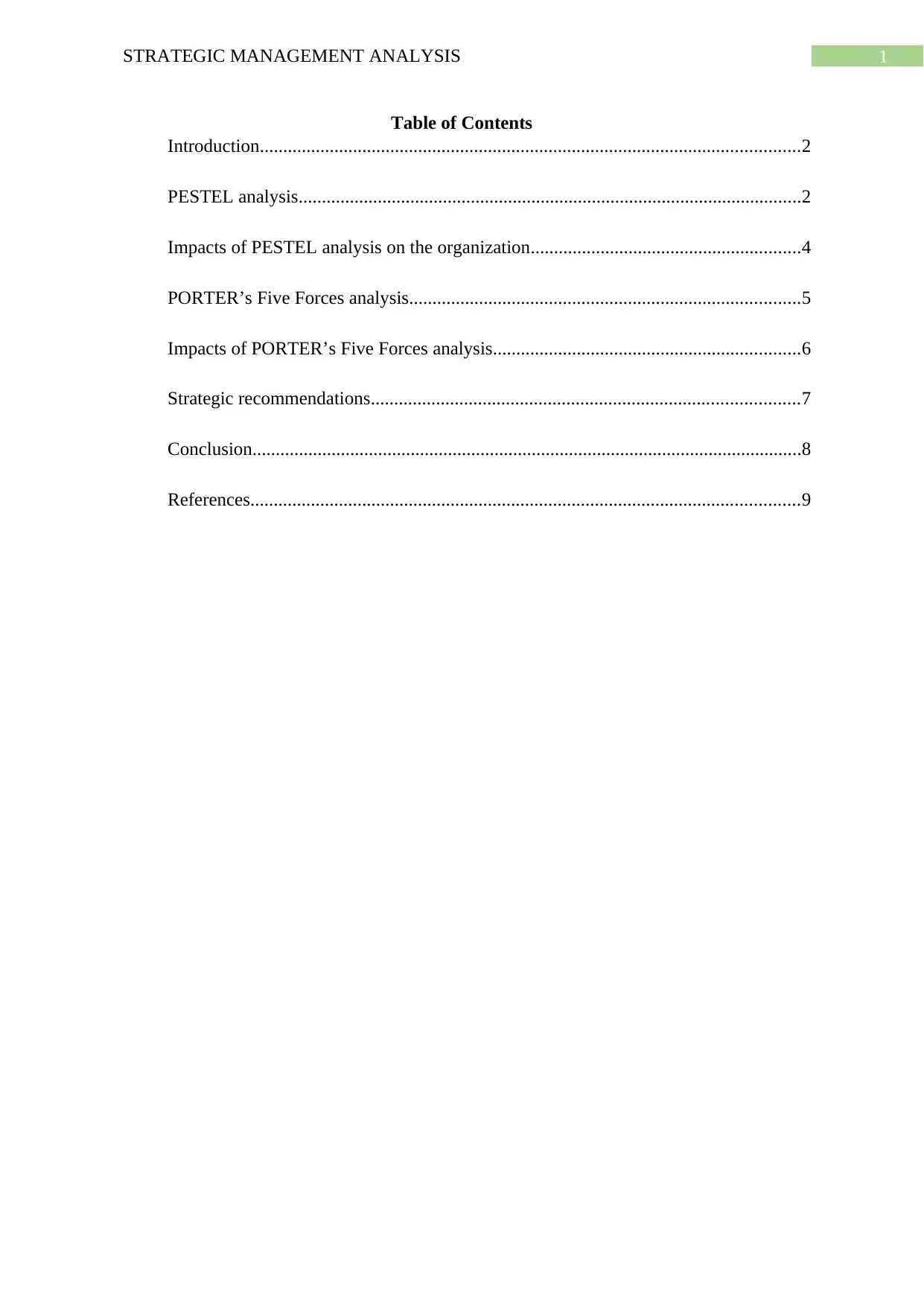
1STRATEGIC MANAGEMENT ANALYSIS
Table of Contents
Introduction....................................................................................................................2
PESTEL analysis............................................................................................................2
Impacts of PESTEL analysis on the organization..........................................................4
PORTER’s Five Forces analysis....................................................................................5
Impacts of PORTER’s Five Forces analysis..................................................................6
Strategic recommendations............................................................................................7
Conclusion......................................................................................................................8
References......................................................................................................................9
Table of Contents
Introduction....................................................................................................................2
PESTEL analysis............................................................................................................2
Impacts of PESTEL analysis on the organization..........................................................4
PORTER’s Five Forces analysis....................................................................................5
Impacts of PORTER’s Five Forces analysis..................................................................6
Strategic recommendations............................................................................................7
Conclusion......................................................................................................................8
References......................................................................................................................9
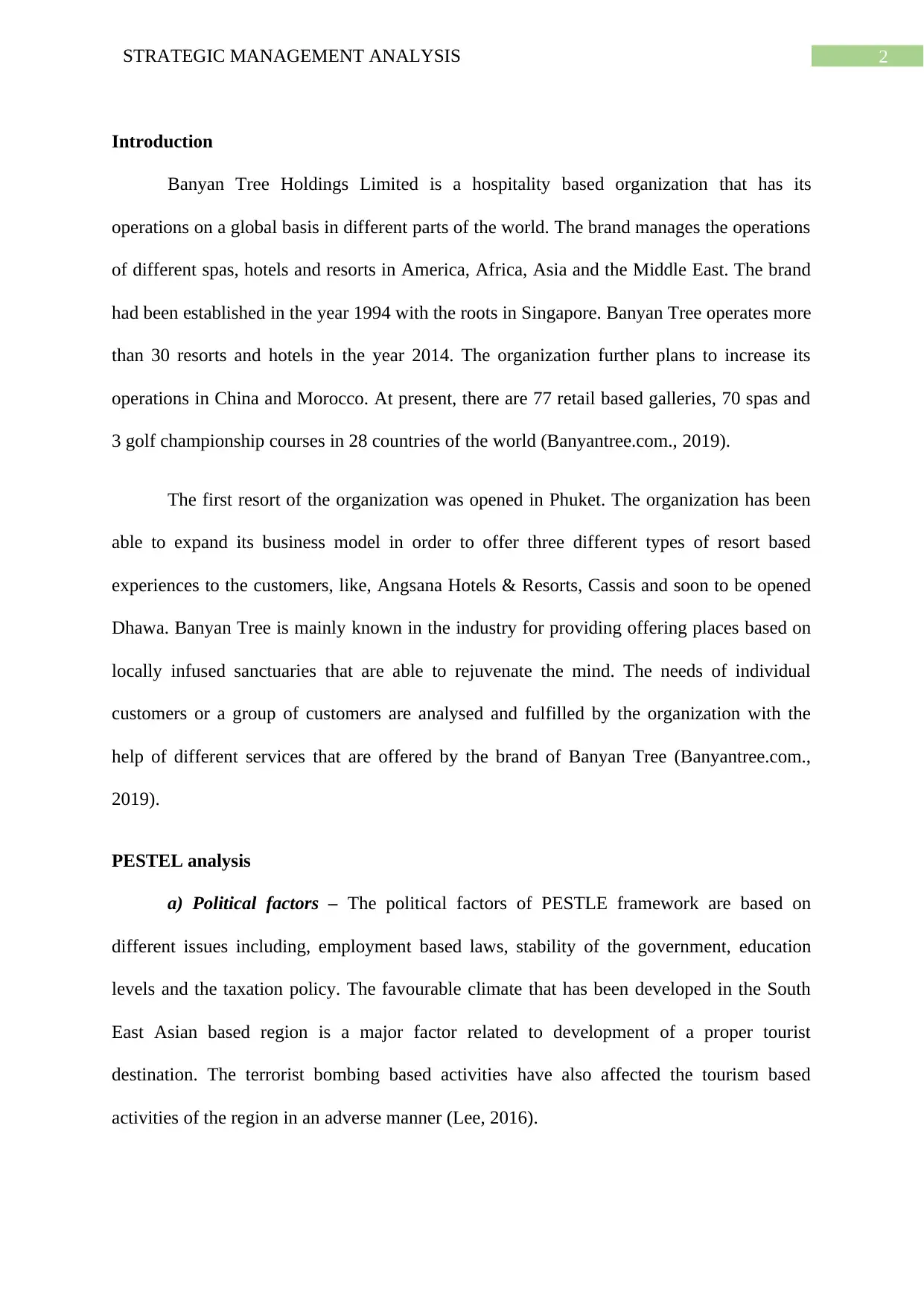
2STRATEGIC MANAGEMENT ANALYSIS
Introduction
Banyan Tree Holdings Limited is a hospitality based organization that has its
operations on a global basis in different parts of the world. The brand manages the operations
of different spas, hotels and resorts in America, Africa, Asia and the Middle East. The brand
had been established in the year 1994 with the roots in Singapore. Banyan Tree operates more
than 30 resorts and hotels in the year 2014. The organization further plans to increase its
operations in China and Morocco. At present, there are 77 retail based galleries, 70 spas and
3 golf championship courses in 28 countries of the world (Banyantree.com., 2019).
The first resort of the organization was opened in Phuket. The organization has been
able to expand its business model in order to offer three different types of resort based
experiences to the customers, like, Angsana Hotels & Resorts, Cassis and soon to be opened
Dhawa. Banyan Tree is mainly known in the industry for providing offering places based on
locally infused sanctuaries that are able to rejuvenate the mind. The needs of individual
customers or a group of customers are analysed and fulfilled by the organization with the
help of different services that are offered by the brand of Banyan Tree (Banyantree.com.,
2019).
PESTEL analysis
a) Political factors – The political factors of PESTLE framework are based on
different issues including, employment based laws, stability of the government, education
levels and the taxation policy. The favourable climate that has been developed in the South
East Asian based region is a major factor related to development of a proper tourist
destination. The terrorist bombing based activities have also affected the tourism based
activities of the region in an adverse manner (Lee, 2016).
Introduction
Banyan Tree Holdings Limited is a hospitality based organization that has its
operations on a global basis in different parts of the world. The brand manages the operations
of different spas, hotels and resorts in America, Africa, Asia and the Middle East. The brand
had been established in the year 1994 with the roots in Singapore. Banyan Tree operates more
than 30 resorts and hotels in the year 2014. The organization further plans to increase its
operations in China and Morocco. At present, there are 77 retail based galleries, 70 spas and
3 golf championship courses in 28 countries of the world (Banyantree.com., 2019).
The first resort of the organization was opened in Phuket. The organization has been
able to expand its business model in order to offer three different types of resort based
experiences to the customers, like, Angsana Hotels & Resorts, Cassis and soon to be opened
Dhawa. Banyan Tree is mainly known in the industry for providing offering places based on
locally infused sanctuaries that are able to rejuvenate the mind. The needs of individual
customers or a group of customers are analysed and fulfilled by the organization with the
help of different services that are offered by the brand of Banyan Tree (Banyantree.com.,
2019).
PESTEL analysis
a) Political factors – The political factors of PESTLE framework are based on
different issues including, employment based laws, stability of the government, education
levels and the taxation policy. The favourable climate that has been developed in the South
East Asian based region is a major factor related to development of a proper tourist
destination. The terrorist bombing based activities have also affected the tourism based
activities of the region in an adverse manner (Lee, 2016).
⊘ This is a preview!⊘
Do you want full access?
Subscribe today to unlock all pages.

Trusted by 1+ million students worldwide
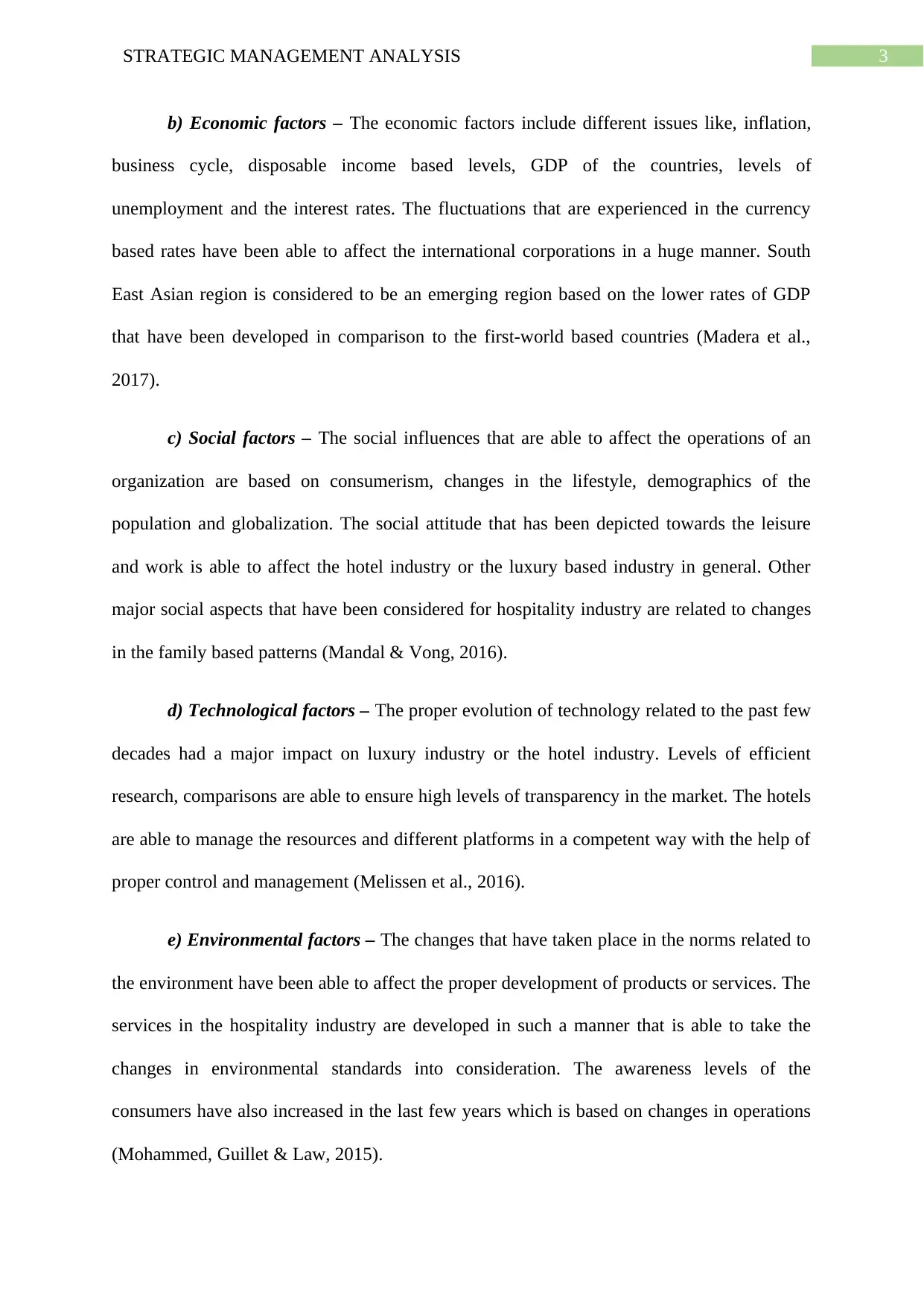
3STRATEGIC MANAGEMENT ANALYSIS
b) Economic factors – The economic factors include different issues like, inflation,
business cycle, disposable income based levels, GDP of the countries, levels of
unemployment and the interest rates. The fluctuations that are experienced in the currency
based rates have been able to affect the international corporations in a huge manner. South
East Asian region is considered to be an emerging region based on the lower rates of GDP
that have been developed in comparison to the first-world based countries (Madera et al.,
2017).
c) Social factors – The social influences that are able to affect the operations of an
organization are based on consumerism, changes in the lifestyle, demographics of the
population and globalization. The social attitude that has been depicted towards the leisure
and work is able to affect the hotel industry or the luxury based industry in general. Other
major social aspects that have been considered for hospitality industry are related to changes
in the family based patterns (Mandal & Vong, 2016).
d) Technological factors – The proper evolution of technology related to the past few
decades had a major impact on luxury industry or the hotel industry. Levels of efficient
research, comparisons are able to ensure high levels of transparency in the market. The hotels
are able to manage the resources and different platforms in a competent way with the help of
proper control and management (Melissen et al., 2016).
e) Environmental factors – The changes that have taken place in the norms related to
the environment have been able to affect the proper development of products or services. The
services in the hospitality industry are developed in such a manner that is able to take the
changes in environmental standards into consideration. The awareness levels of the
consumers have also increased in the last few years which is based on changes in operations
(Mohammed, Guillet & Law, 2015).
b) Economic factors – The economic factors include different issues like, inflation,
business cycle, disposable income based levels, GDP of the countries, levels of
unemployment and the interest rates. The fluctuations that are experienced in the currency
based rates have been able to affect the international corporations in a huge manner. South
East Asian region is considered to be an emerging region based on the lower rates of GDP
that have been developed in comparison to the first-world based countries (Madera et al.,
2017).
c) Social factors – The social influences that are able to affect the operations of an
organization are based on consumerism, changes in the lifestyle, demographics of the
population and globalization. The social attitude that has been depicted towards the leisure
and work is able to affect the hotel industry or the luxury based industry in general. Other
major social aspects that have been considered for hospitality industry are related to changes
in the family based patterns (Mandal & Vong, 2016).
d) Technological factors – The proper evolution of technology related to the past few
decades had a major impact on luxury industry or the hotel industry. Levels of efficient
research, comparisons are able to ensure high levels of transparency in the market. The hotels
are able to manage the resources and different platforms in a competent way with the help of
proper control and management (Melissen et al., 2016).
e) Environmental factors – The changes that have taken place in the norms related to
the environment have been able to affect the proper development of products or services. The
services in the hospitality industry are developed in such a manner that is able to take the
changes in environmental standards into consideration. The awareness levels of the
consumers have also increased in the last few years which is based on changes in operations
(Mohammed, Guillet & Law, 2015).
Paraphrase This Document
Need a fresh take? Get an instant paraphrase of this document with our AI Paraphraser
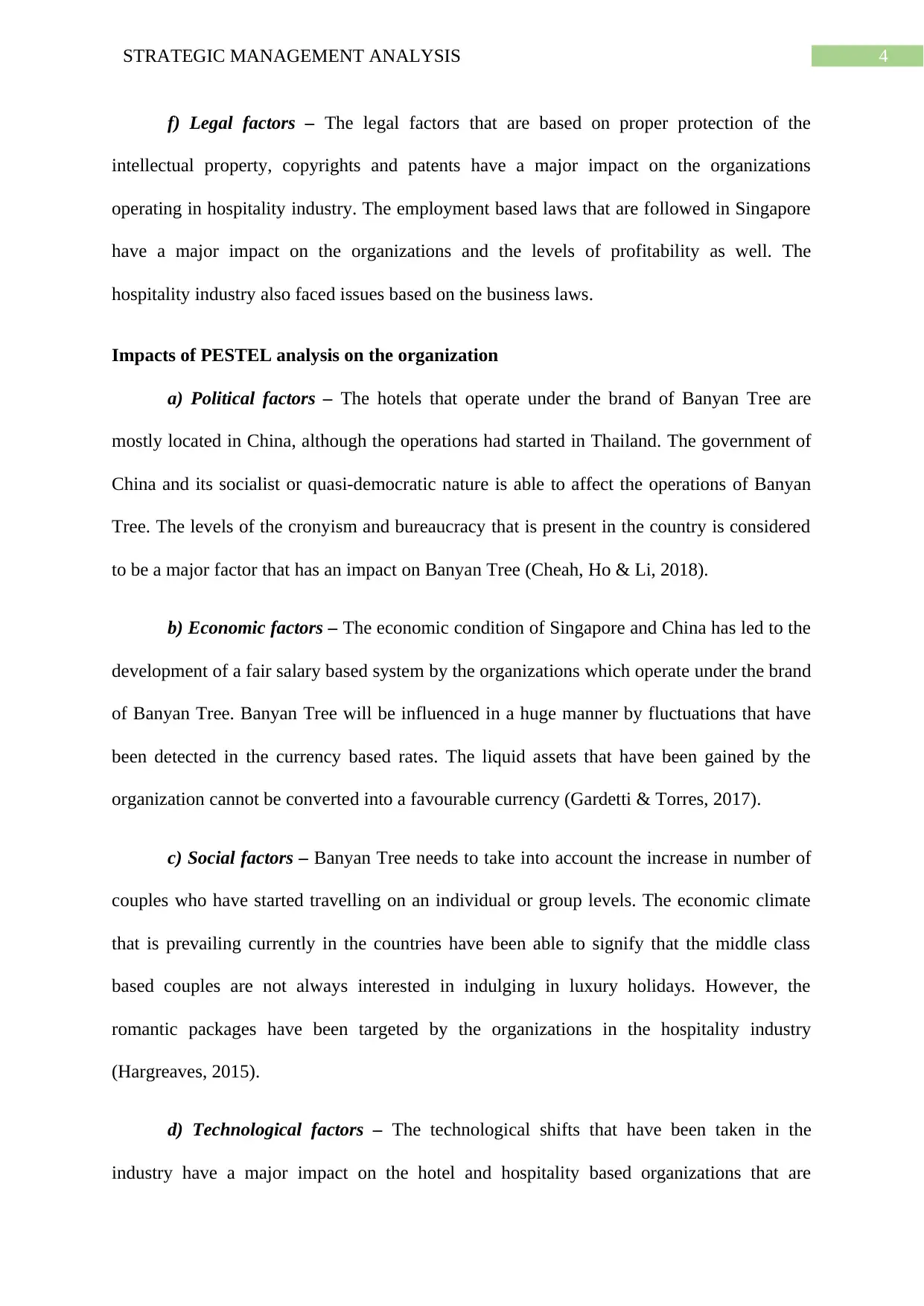
4STRATEGIC MANAGEMENT ANALYSIS
f) Legal factors – The legal factors that are based on proper protection of the
intellectual property, copyrights and patents have a major impact on the organizations
operating in hospitality industry. The employment based laws that are followed in Singapore
have a major impact on the organizations and the levels of profitability as well. The
hospitality industry also faced issues based on the business laws.
Impacts of PESTEL analysis on the organization
a) Political factors – The hotels that operate under the brand of Banyan Tree are
mostly located in China, although the operations had started in Thailand. The government of
China and its socialist or quasi-democratic nature is able to affect the operations of Banyan
Tree. The levels of the cronyism and bureaucracy that is present in the country is considered
to be a major factor that has an impact on Banyan Tree (Cheah, Ho & Li, 2018).
b) Economic factors – The economic condition of Singapore and China has led to the
development of a fair salary based system by the organizations which operate under the brand
of Banyan Tree. Banyan Tree will be influenced in a huge manner by fluctuations that have
been detected in the currency based rates. The liquid assets that have been gained by the
organization cannot be converted into a favourable currency (Gardetti & Torres, 2017).
c) Social factors – Banyan Tree needs to take into account the increase in number of
couples who have started travelling on an individual or group levels. The economic climate
that is prevailing currently in the countries have been able to signify that the middle class
based couples are not always interested in indulging in luxury holidays. However, the
romantic packages have been targeted by the organizations in the hospitality industry
(Hargreaves, 2015).
d) Technological factors – The technological shifts that have been taken in the
industry have a major impact on the hotel and hospitality based organizations that are
f) Legal factors – The legal factors that are based on proper protection of the
intellectual property, copyrights and patents have a major impact on the organizations
operating in hospitality industry. The employment based laws that are followed in Singapore
have a major impact on the organizations and the levels of profitability as well. The
hospitality industry also faced issues based on the business laws.
Impacts of PESTEL analysis on the organization
a) Political factors – The hotels that operate under the brand of Banyan Tree are
mostly located in China, although the operations had started in Thailand. The government of
China and its socialist or quasi-democratic nature is able to affect the operations of Banyan
Tree. The levels of the cronyism and bureaucracy that is present in the country is considered
to be a major factor that has an impact on Banyan Tree (Cheah, Ho & Li, 2018).
b) Economic factors – The economic condition of Singapore and China has led to the
development of a fair salary based system by the organizations which operate under the brand
of Banyan Tree. Banyan Tree will be influenced in a huge manner by fluctuations that have
been detected in the currency based rates. The liquid assets that have been gained by the
organization cannot be converted into a favourable currency (Gardetti & Torres, 2017).
c) Social factors – Banyan Tree needs to take into account the increase in number of
couples who have started travelling on an individual or group levels. The economic climate
that is prevailing currently in the countries have been able to signify that the middle class
based couples are not always interested in indulging in luxury holidays. However, the
romantic packages have been targeted by the organizations in the hospitality industry
(Hargreaves, 2015).
d) Technological factors – The technological shifts that have been taken in the
industry have a major impact on the hotel and hospitality based organizations that are
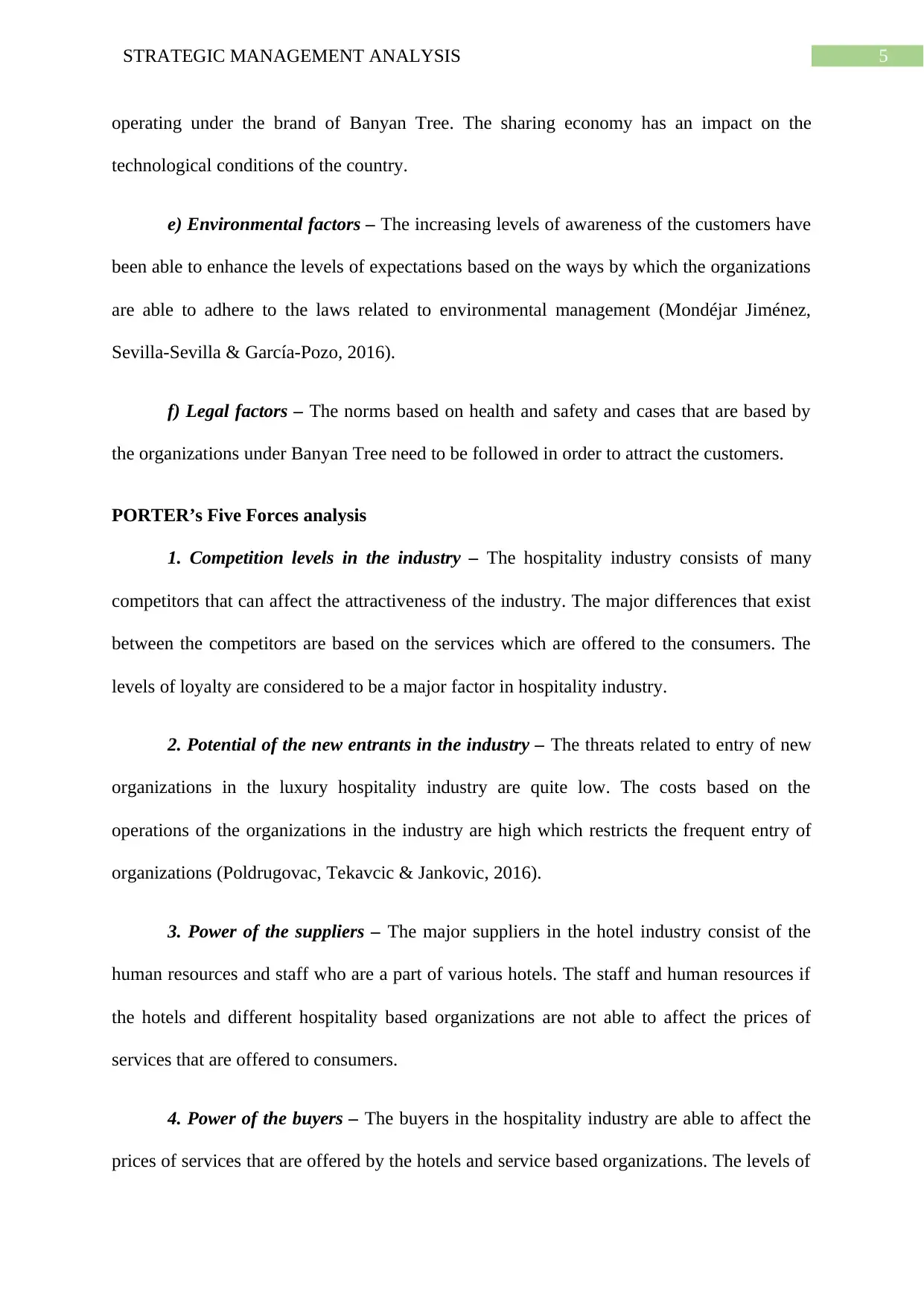
5STRATEGIC MANAGEMENT ANALYSIS
operating under the brand of Banyan Tree. The sharing economy has an impact on the
technological conditions of the country.
e) Environmental factors – The increasing levels of awareness of the customers have
been able to enhance the levels of expectations based on the ways by which the organizations
are able to adhere to the laws related to environmental management (Mondéjar Jiménez,
Sevilla-Sevilla & García-Pozo, 2016).
f) Legal factors – The norms based on health and safety and cases that are based by
the organizations under Banyan Tree need to be followed in order to attract the customers.
PORTER’s Five Forces analysis
1. Competition levels in the industry – The hospitality industry consists of many
competitors that can affect the attractiveness of the industry. The major differences that exist
between the competitors are based on the services which are offered to the consumers. The
levels of loyalty are considered to be a major factor in hospitality industry.
2. Potential of the new entrants in the industry – The threats related to entry of new
organizations in the luxury hospitality industry are quite low. The costs based on the
operations of the organizations in the industry are high which restricts the frequent entry of
organizations (Poldrugovac, Tekavcic & Jankovic, 2016).
3. Power of the suppliers – The major suppliers in the hotel industry consist of the
human resources and staff who are a part of various hotels. The staff and human resources if
the hotels and different hospitality based organizations are not able to affect the prices of
services that are offered to consumers.
4. Power of the buyers – The buyers in the hospitality industry are able to affect the
prices of services that are offered by the hotels and service based organizations. The levels of
operating under the brand of Banyan Tree. The sharing economy has an impact on the
technological conditions of the country.
e) Environmental factors – The increasing levels of awareness of the customers have
been able to enhance the levels of expectations based on the ways by which the organizations
are able to adhere to the laws related to environmental management (Mondéjar Jiménez,
Sevilla-Sevilla & García-Pozo, 2016).
f) Legal factors – The norms based on health and safety and cases that are based by
the organizations under Banyan Tree need to be followed in order to attract the customers.
PORTER’s Five Forces analysis
1. Competition levels in the industry – The hospitality industry consists of many
competitors that can affect the attractiveness of the industry. The major differences that exist
between the competitors are based on the services which are offered to the consumers. The
levels of loyalty are considered to be a major factor in hospitality industry.
2. Potential of the new entrants in the industry – The threats related to entry of new
organizations in the luxury hospitality industry are quite low. The costs based on the
operations of the organizations in the industry are high which restricts the frequent entry of
organizations (Poldrugovac, Tekavcic & Jankovic, 2016).
3. Power of the suppliers – The major suppliers in the hotel industry consist of the
human resources and staff who are a part of various hotels. The staff and human resources if
the hotels and different hospitality based organizations are not able to affect the prices of
services that are offered to consumers.
4. Power of the buyers – The buyers in the hospitality industry are able to affect the
prices of services that are offered by the hotels and service based organizations. The levels of
⊘ This is a preview!⊘
Do you want full access?
Subscribe today to unlock all pages.

Trusted by 1+ million students worldwide
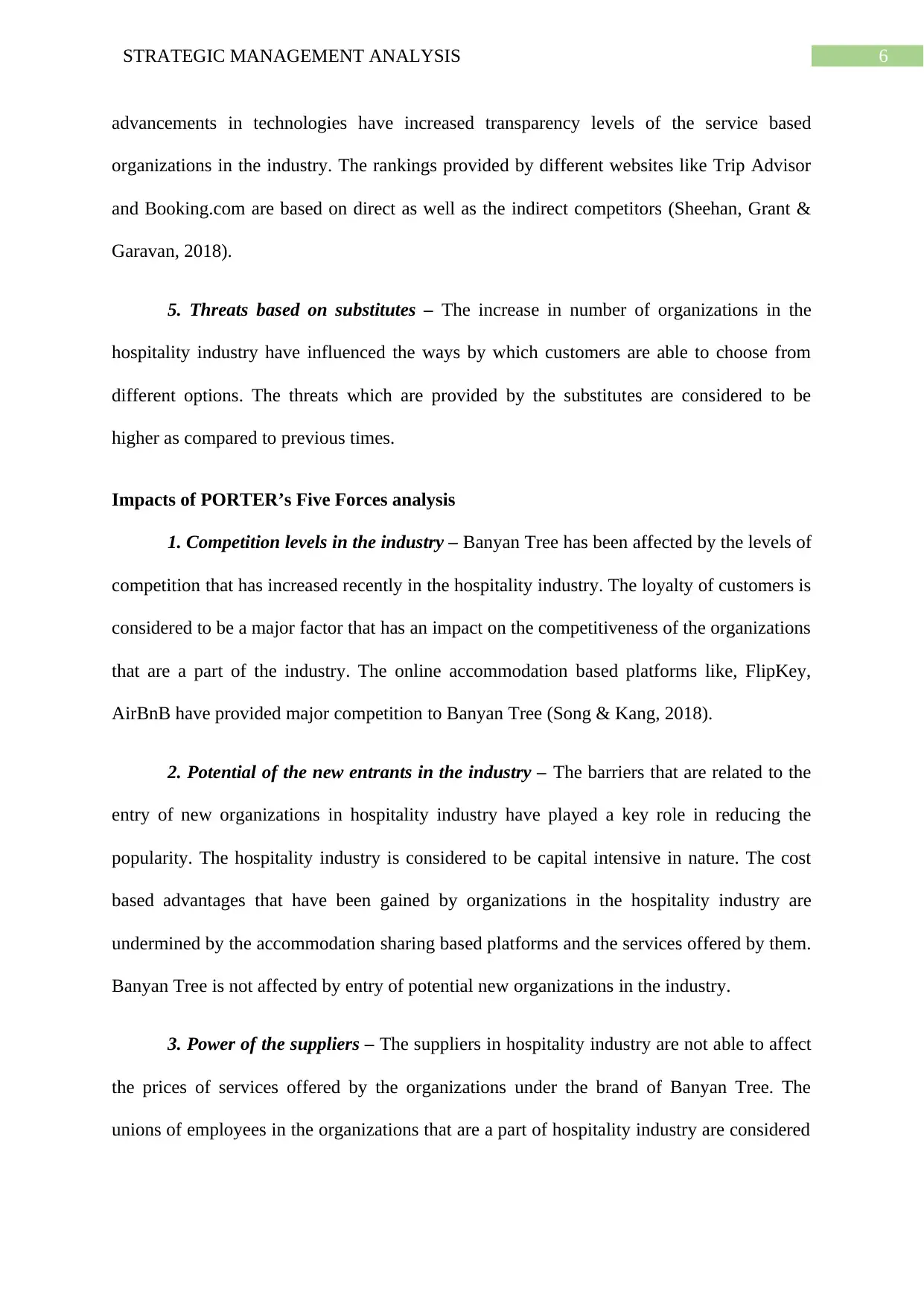
6STRATEGIC MANAGEMENT ANALYSIS
advancements in technologies have increased transparency levels of the service based
organizations in the industry. The rankings provided by different websites like Trip Advisor
and Booking.com are based on direct as well as the indirect competitors (Sheehan, Grant &
Garavan, 2018).
5. Threats based on substitutes – The increase in number of organizations in the
hospitality industry have influenced the ways by which customers are able to choose from
different options. The threats which are provided by the substitutes are considered to be
higher as compared to previous times.
Impacts of PORTER’s Five Forces analysis
1. Competition levels in the industry – Banyan Tree has been affected by the levels of
competition that has increased recently in the hospitality industry. The loyalty of customers is
considered to be a major factor that has an impact on the competitiveness of the organizations
that are a part of the industry. The online accommodation based platforms like, FlipKey,
AirBnB have provided major competition to Banyan Tree (Song & Kang, 2018).
2. Potential of the new entrants in the industry – The barriers that are related to the
entry of new organizations in hospitality industry have played a key role in reducing the
popularity. The hospitality industry is considered to be capital intensive in nature. The cost
based advantages that have been gained by organizations in the hospitality industry are
undermined by the accommodation sharing based platforms and the services offered by them.
Banyan Tree is not affected by entry of potential new organizations in the industry.
3. Power of the suppliers – The suppliers in hospitality industry are not able to affect
the prices of services offered by the organizations under the brand of Banyan Tree. The
unions of employees in the organizations that are a part of hospitality industry are considered
advancements in technologies have increased transparency levels of the service based
organizations in the industry. The rankings provided by different websites like Trip Advisor
and Booking.com are based on direct as well as the indirect competitors (Sheehan, Grant &
Garavan, 2018).
5. Threats based on substitutes – The increase in number of organizations in the
hospitality industry have influenced the ways by which customers are able to choose from
different options. The threats which are provided by the substitutes are considered to be
higher as compared to previous times.
Impacts of PORTER’s Five Forces analysis
1. Competition levels in the industry – Banyan Tree has been affected by the levels of
competition that has increased recently in the hospitality industry. The loyalty of customers is
considered to be a major factor that has an impact on the competitiveness of the organizations
that are a part of the industry. The online accommodation based platforms like, FlipKey,
AirBnB have provided major competition to Banyan Tree (Song & Kang, 2018).
2. Potential of the new entrants in the industry – The barriers that are related to the
entry of new organizations in hospitality industry have played a key role in reducing the
popularity. The hospitality industry is considered to be capital intensive in nature. The cost
based advantages that have been gained by organizations in the hospitality industry are
undermined by the accommodation sharing based platforms and the services offered by them.
Banyan Tree is not affected by entry of potential new organizations in the industry.
3. Power of the suppliers – The suppliers in hospitality industry are not able to affect
the prices of services offered by the organizations under the brand of Banyan Tree. The
unions of employees in the organizations that are a part of hospitality industry are considered
Paraphrase This Document
Need a fresh take? Get an instant paraphrase of this document with our AI Paraphraser
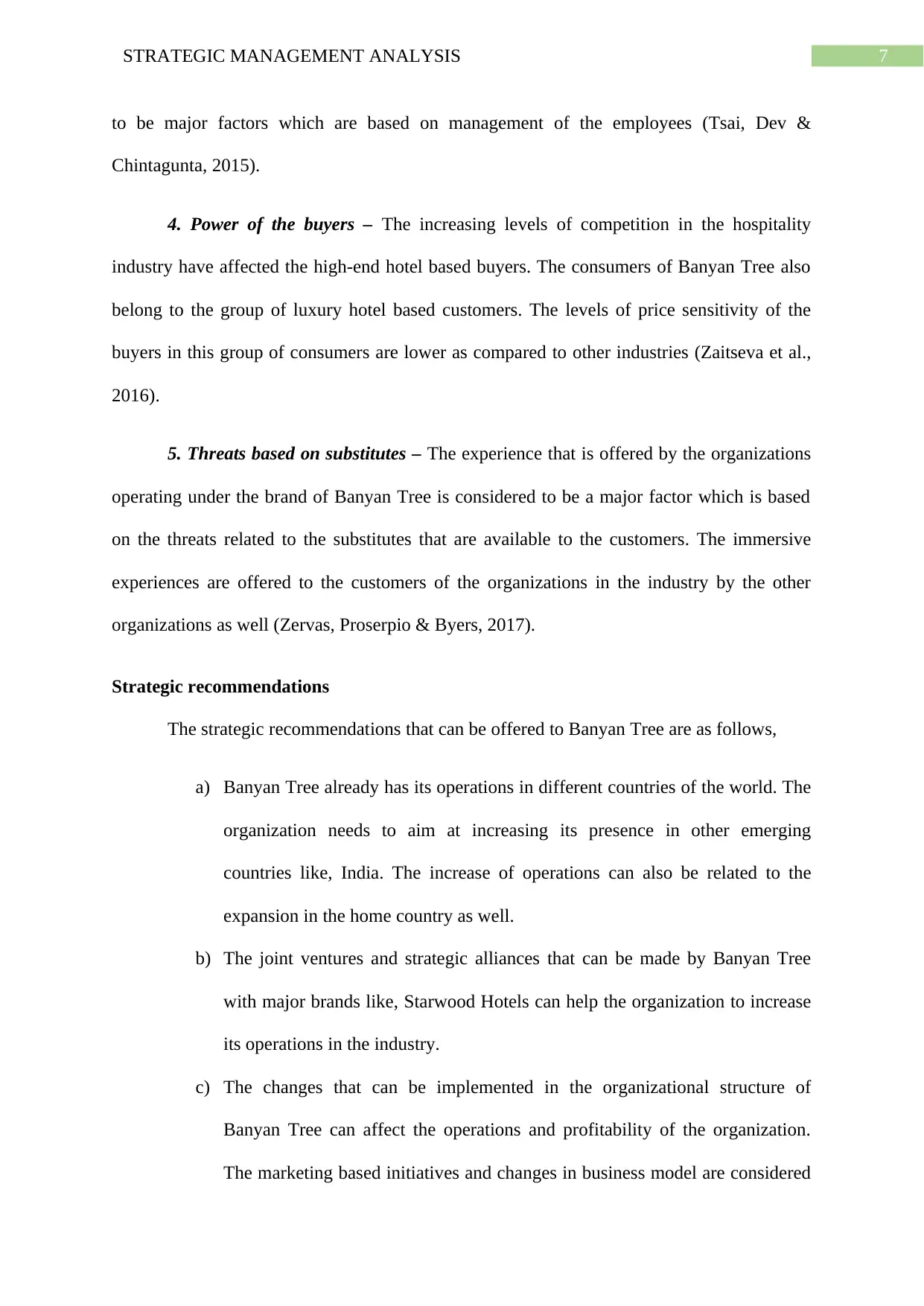
7STRATEGIC MANAGEMENT ANALYSIS
to be major factors which are based on management of the employees (Tsai, Dev &
Chintagunta, 2015).
4. Power of the buyers – The increasing levels of competition in the hospitality
industry have affected the high-end hotel based buyers. The consumers of Banyan Tree also
belong to the group of luxury hotel based customers. The levels of price sensitivity of the
buyers in this group of consumers are lower as compared to other industries (Zaitseva et al.,
2016).
5. Threats based on substitutes – The experience that is offered by the organizations
operating under the brand of Banyan Tree is considered to be a major factor which is based
on the threats related to the substitutes that are available to the customers. The immersive
experiences are offered to the customers of the organizations in the industry by the other
organizations as well (Zervas, Proserpio & Byers, 2017).
Strategic recommendations
The strategic recommendations that can be offered to Banyan Tree are as follows,
a) Banyan Tree already has its operations in different countries of the world. The
organization needs to aim at increasing its presence in other emerging
countries like, India. The increase of operations can also be related to the
expansion in the home country as well.
b) The joint ventures and strategic alliances that can be made by Banyan Tree
with major brands like, Starwood Hotels can help the organization to increase
its operations in the industry.
c) The changes that can be implemented in the organizational structure of
Banyan Tree can affect the operations and profitability of the organization.
The marketing based initiatives and changes in business model are considered
to be major factors which are based on management of the employees (Tsai, Dev &
Chintagunta, 2015).
4. Power of the buyers – The increasing levels of competition in the hospitality
industry have affected the high-end hotel based buyers. The consumers of Banyan Tree also
belong to the group of luxury hotel based customers. The levels of price sensitivity of the
buyers in this group of consumers are lower as compared to other industries (Zaitseva et al.,
2016).
5. Threats based on substitutes – The experience that is offered by the organizations
operating under the brand of Banyan Tree is considered to be a major factor which is based
on the threats related to the substitutes that are available to the customers. The immersive
experiences are offered to the customers of the organizations in the industry by the other
organizations as well (Zervas, Proserpio & Byers, 2017).
Strategic recommendations
The strategic recommendations that can be offered to Banyan Tree are as follows,
a) Banyan Tree already has its operations in different countries of the world. The
organization needs to aim at increasing its presence in other emerging
countries like, India. The increase of operations can also be related to the
expansion in the home country as well.
b) The joint ventures and strategic alliances that can be made by Banyan Tree
with major brands like, Starwood Hotels can help the organization to increase
its operations in the industry.
c) The changes that can be implemented in the organizational structure of
Banyan Tree can affect the operations and profitability of the organization.
The marketing based initiatives and changes in business model are considered
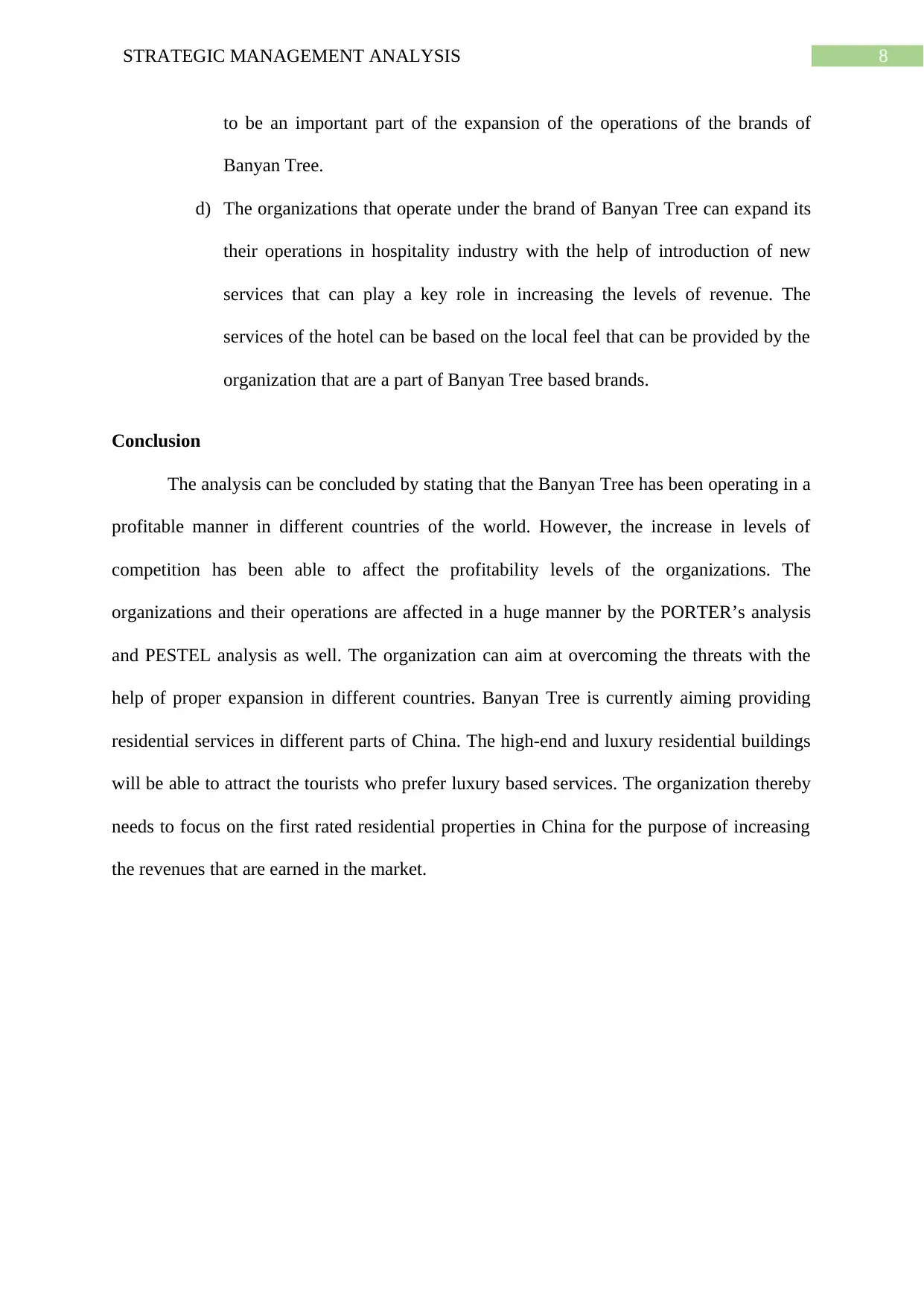
8STRATEGIC MANAGEMENT ANALYSIS
to be an important part of the expansion of the operations of the brands of
Banyan Tree.
d) The organizations that operate under the brand of Banyan Tree can expand its
their operations in hospitality industry with the help of introduction of new
services that can play a key role in increasing the levels of revenue. The
services of the hotel can be based on the local feel that can be provided by the
organization that are a part of Banyan Tree based brands.
Conclusion
The analysis can be concluded by stating that the Banyan Tree has been operating in a
profitable manner in different countries of the world. However, the increase in levels of
competition has been able to affect the profitability levels of the organizations. The
organizations and their operations are affected in a huge manner by the PORTER’s analysis
and PESTEL analysis as well. The organization can aim at overcoming the threats with the
help of proper expansion in different countries. Banyan Tree is currently aiming providing
residential services in different parts of China. The high-end and luxury residential buildings
will be able to attract the tourists who prefer luxury based services. The organization thereby
needs to focus on the first rated residential properties in China for the purpose of increasing
the revenues that are earned in the market.
to be an important part of the expansion of the operations of the brands of
Banyan Tree.
d) The organizations that operate under the brand of Banyan Tree can expand its
their operations in hospitality industry with the help of introduction of new
services that can play a key role in increasing the levels of revenue. The
services of the hotel can be based on the local feel that can be provided by the
organization that are a part of Banyan Tree based brands.
Conclusion
The analysis can be concluded by stating that the Banyan Tree has been operating in a
profitable manner in different countries of the world. However, the increase in levels of
competition has been able to affect the profitability levels of the organizations. The
organizations and their operations are affected in a huge manner by the PORTER’s analysis
and PESTEL analysis as well. The organization can aim at overcoming the threats with the
help of proper expansion in different countries. Banyan Tree is currently aiming providing
residential services in different parts of China. The high-end and luxury residential buildings
will be able to attract the tourists who prefer luxury based services. The organization thereby
needs to focus on the first rated residential properties in China for the purpose of increasing
the revenues that are earned in the market.
⊘ This is a preview!⊘
Do you want full access?
Subscribe today to unlock all pages.

Trusted by 1+ million students worldwide
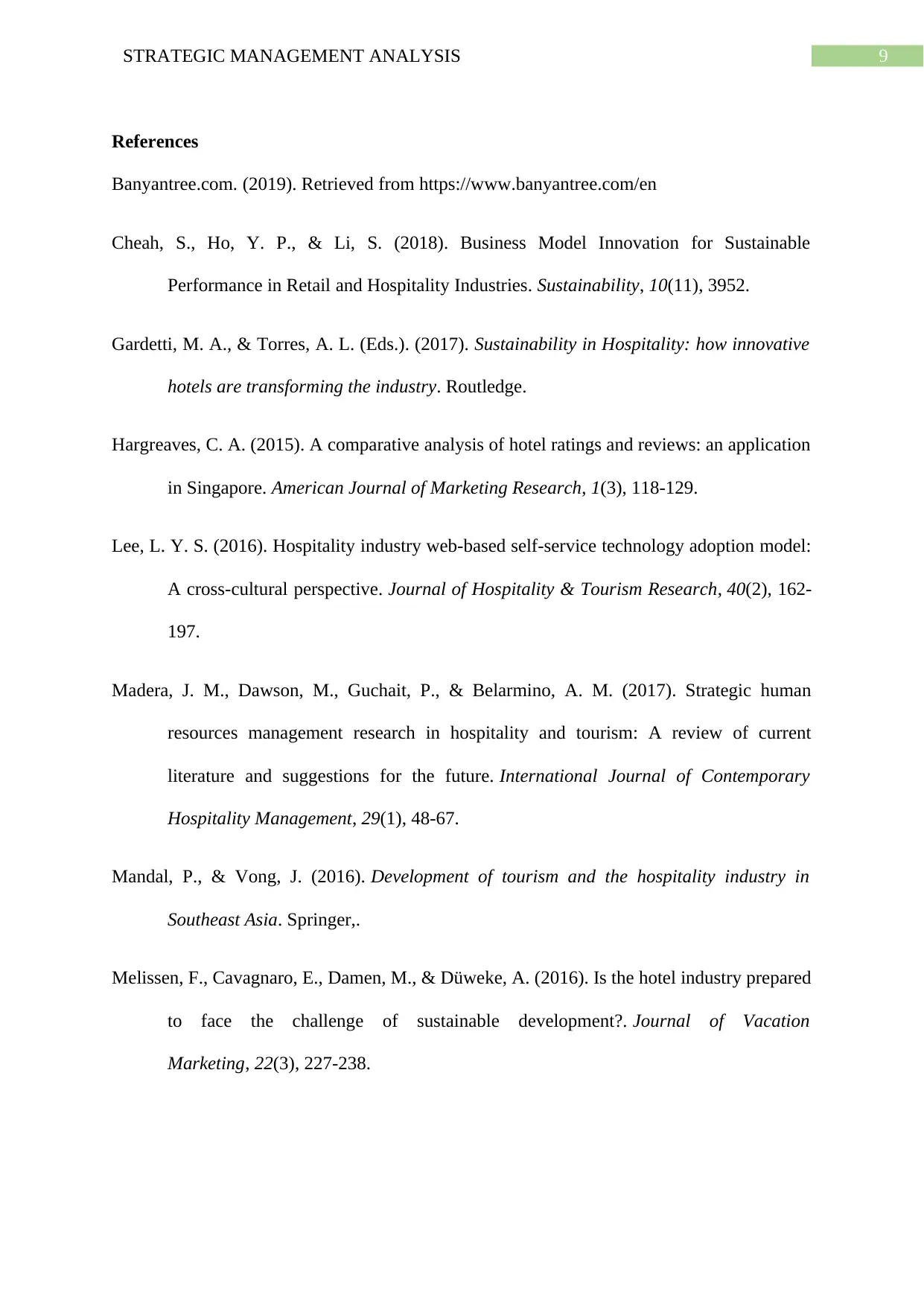
9STRATEGIC MANAGEMENT ANALYSIS
References
Banyantree.com. (2019). Retrieved from https://www.banyantree.com/en
Cheah, S., Ho, Y. P., & Li, S. (2018). Business Model Innovation for Sustainable
Performance in Retail and Hospitality Industries. Sustainability, 10(11), 3952.
Gardetti, M. A., & Torres, A. L. (Eds.). (2017). Sustainability in Hospitality: how innovative
hotels are transforming the industry. Routledge.
Hargreaves, C. A. (2015). A comparative analysis of hotel ratings and reviews: an application
in Singapore. American Journal of Marketing Research, 1(3), 118-129.
Lee, L. Y. S. (2016). Hospitality industry web-based self-service technology adoption model:
A cross-cultural perspective. Journal of Hospitality & Tourism Research, 40(2), 162-
197.
Madera, J. M., Dawson, M., Guchait, P., & Belarmino, A. M. (2017). Strategic human
resources management research in hospitality and tourism: A review of current
literature and suggestions for the future. International Journal of Contemporary
Hospitality Management, 29(1), 48-67.
Mandal, P., & Vong, J. (2016). Development of tourism and the hospitality industry in
Southeast Asia. Springer,.
Melissen, F., Cavagnaro, E., Damen, M., & Düweke, A. (2016). Is the hotel industry prepared
to face the challenge of sustainable development?. Journal of Vacation
Marketing, 22(3), 227-238.
References
Banyantree.com. (2019). Retrieved from https://www.banyantree.com/en
Cheah, S., Ho, Y. P., & Li, S. (2018). Business Model Innovation for Sustainable
Performance in Retail and Hospitality Industries. Sustainability, 10(11), 3952.
Gardetti, M. A., & Torres, A. L. (Eds.). (2017). Sustainability in Hospitality: how innovative
hotels are transforming the industry. Routledge.
Hargreaves, C. A. (2015). A comparative analysis of hotel ratings and reviews: an application
in Singapore. American Journal of Marketing Research, 1(3), 118-129.
Lee, L. Y. S. (2016). Hospitality industry web-based self-service technology adoption model:
A cross-cultural perspective. Journal of Hospitality & Tourism Research, 40(2), 162-
197.
Madera, J. M., Dawson, M., Guchait, P., & Belarmino, A. M. (2017). Strategic human
resources management research in hospitality and tourism: A review of current
literature and suggestions for the future. International Journal of Contemporary
Hospitality Management, 29(1), 48-67.
Mandal, P., & Vong, J. (2016). Development of tourism and the hospitality industry in
Southeast Asia. Springer,.
Melissen, F., Cavagnaro, E., Damen, M., & Düweke, A. (2016). Is the hotel industry prepared
to face the challenge of sustainable development?. Journal of Vacation
Marketing, 22(3), 227-238.
Paraphrase This Document
Need a fresh take? Get an instant paraphrase of this document with our AI Paraphraser
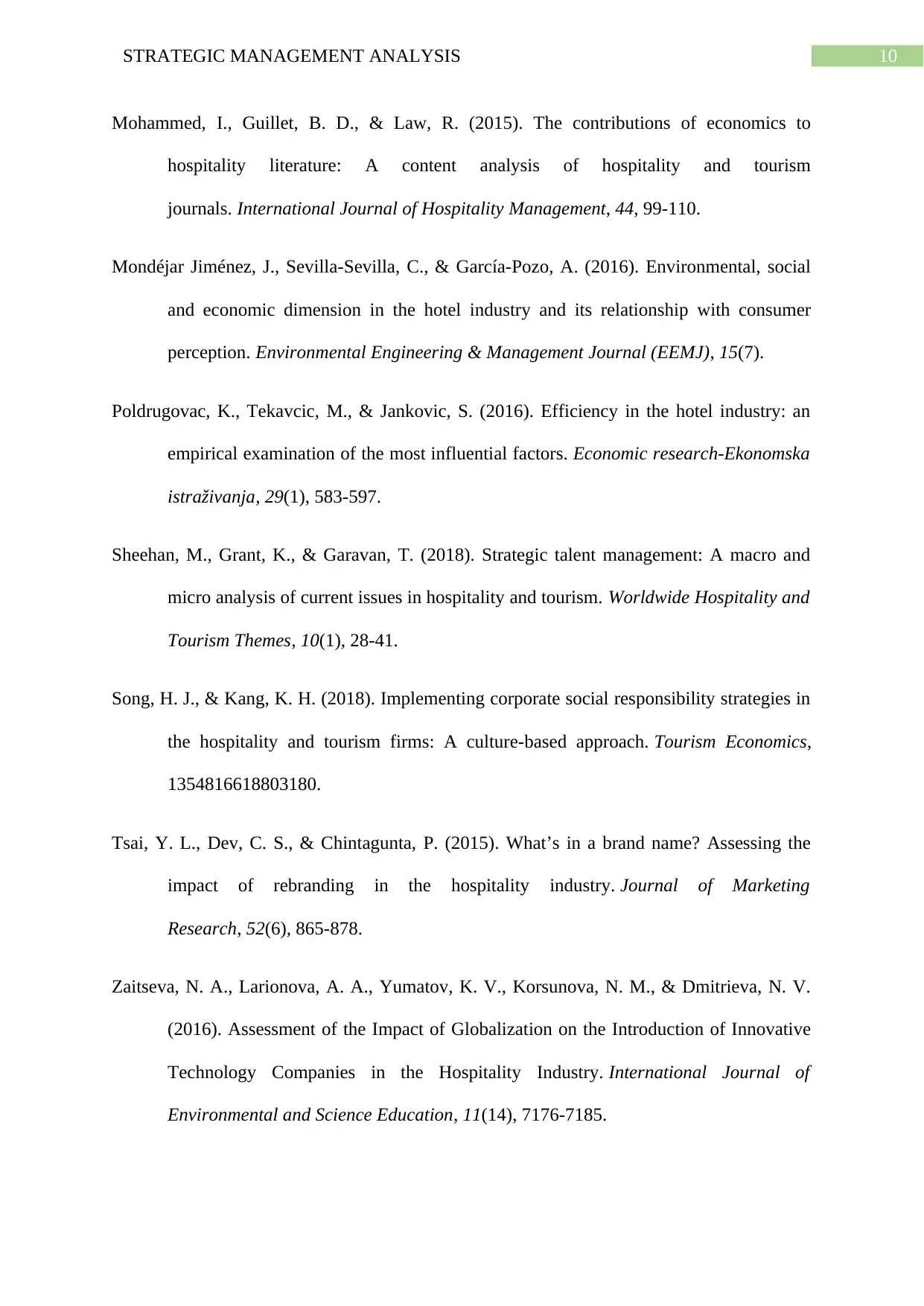
10STRATEGIC MANAGEMENT ANALYSIS
Mohammed, I., Guillet, B. D., & Law, R. (2015). The contributions of economics to
hospitality literature: A content analysis of hospitality and tourism
journals. International Journal of Hospitality Management, 44, 99-110.
Mondéjar Jiménez, J., Sevilla-Sevilla, C., & García-Pozo, A. (2016). Environmental, social
and economic dimension in the hotel industry and its relationship with consumer
perception. Environmental Engineering & Management Journal (EEMJ), 15(7).
Poldrugovac, K., Tekavcic, M., & Jankovic, S. (2016). Efficiency in the hotel industry: an
empirical examination of the most influential factors. Economic research-Ekonomska
istraživanja, 29(1), 583-597.
Sheehan, M., Grant, K., & Garavan, T. (2018). Strategic talent management: A macro and
micro analysis of current issues in hospitality and tourism. Worldwide Hospitality and
Tourism Themes, 10(1), 28-41.
Song, H. J., & Kang, K. H. (2018). Implementing corporate social responsibility strategies in
the hospitality and tourism firms: A culture-based approach. Tourism Economics,
1354816618803180.
Tsai, Y. L., Dev, C. S., & Chintagunta, P. (2015). What’s in a brand name? Assessing the
impact of rebranding in the hospitality industry. Journal of Marketing
Research, 52(6), 865-878.
Zaitseva, N. A., Larionova, A. A., Yumatov, K. V., Korsunova, N. M., & Dmitrieva, N. V.
(2016). Assessment of the Impact of Globalization on the Introduction of Innovative
Technology Companies in the Hospitality Industry. International Journal of
Environmental and Science Education, 11(14), 7176-7185.
Mohammed, I., Guillet, B. D., & Law, R. (2015). The contributions of economics to
hospitality literature: A content analysis of hospitality and tourism
journals. International Journal of Hospitality Management, 44, 99-110.
Mondéjar Jiménez, J., Sevilla-Sevilla, C., & García-Pozo, A. (2016). Environmental, social
and economic dimension in the hotel industry and its relationship with consumer
perception. Environmental Engineering & Management Journal (EEMJ), 15(7).
Poldrugovac, K., Tekavcic, M., & Jankovic, S. (2016). Efficiency in the hotel industry: an
empirical examination of the most influential factors. Economic research-Ekonomska
istraživanja, 29(1), 583-597.
Sheehan, M., Grant, K., & Garavan, T. (2018). Strategic talent management: A macro and
micro analysis of current issues in hospitality and tourism. Worldwide Hospitality and
Tourism Themes, 10(1), 28-41.
Song, H. J., & Kang, K. H. (2018). Implementing corporate social responsibility strategies in
the hospitality and tourism firms: A culture-based approach. Tourism Economics,
1354816618803180.
Tsai, Y. L., Dev, C. S., & Chintagunta, P. (2015). What’s in a brand name? Assessing the
impact of rebranding in the hospitality industry. Journal of Marketing
Research, 52(6), 865-878.
Zaitseva, N. A., Larionova, A. A., Yumatov, K. V., Korsunova, N. M., & Dmitrieva, N. V.
(2016). Assessment of the Impact of Globalization on the Introduction of Innovative
Technology Companies in the Hospitality Industry. International Journal of
Environmental and Science Education, 11(14), 7176-7185.
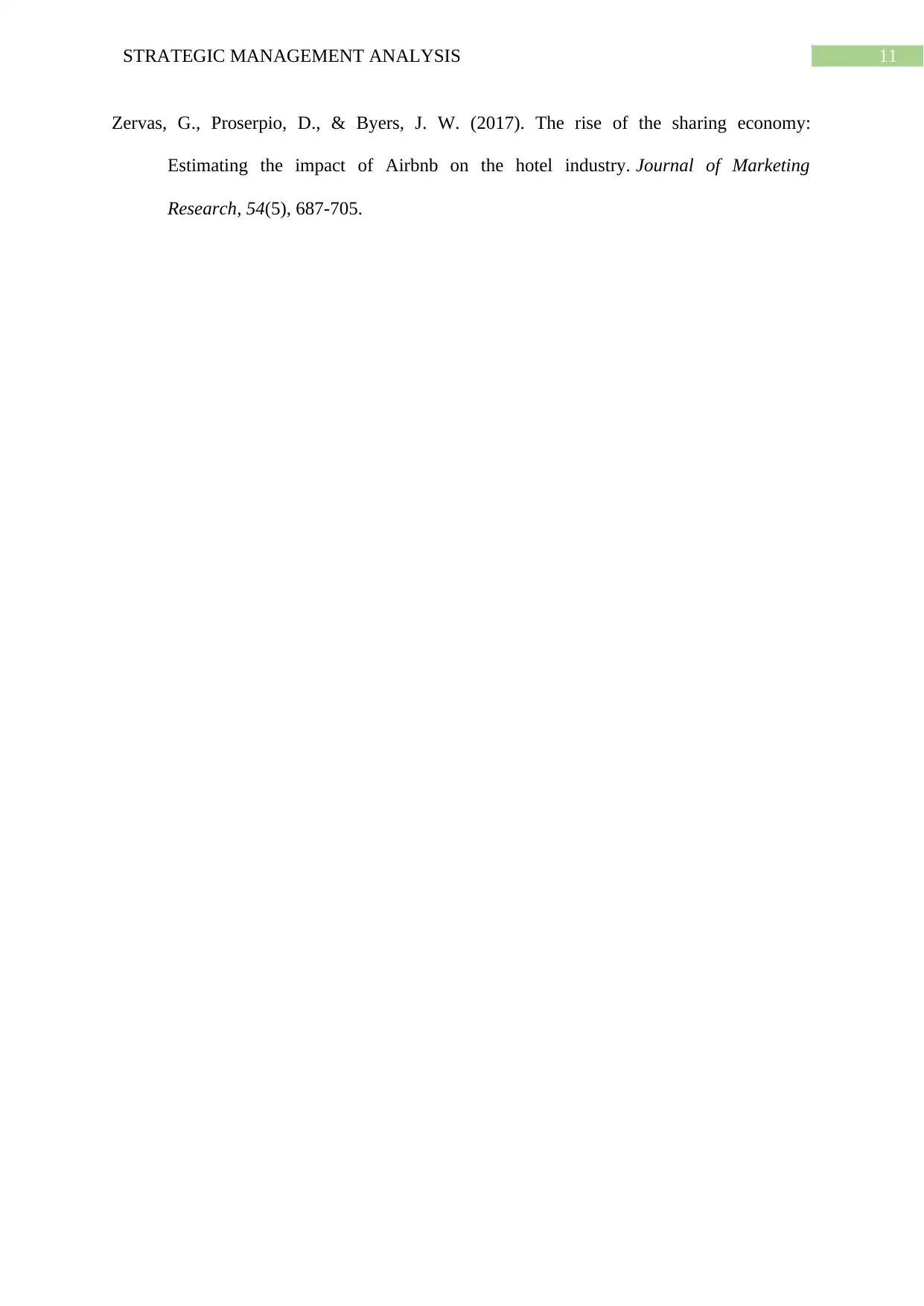
11STRATEGIC MANAGEMENT ANALYSIS
Zervas, G., Proserpio, D., & Byers, J. W. (2017). The rise of the sharing economy:
Estimating the impact of Airbnb on the hotel industry. Journal of Marketing
Research, 54(5), 687-705.
Zervas, G., Proserpio, D., & Byers, J. W. (2017). The rise of the sharing economy:
Estimating the impact of Airbnb on the hotel industry. Journal of Marketing
Research, 54(5), 687-705.
⊘ This is a preview!⊘
Do you want full access?
Subscribe today to unlock all pages.

Trusted by 1+ million students worldwide
1 out of 12
Related Documents
Your All-in-One AI-Powered Toolkit for Academic Success.
+13062052269
info@desklib.com
Available 24*7 on WhatsApp / Email
![[object Object]](/_next/static/media/star-bottom.7253800d.svg)
Unlock your academic potential
Copyright © 2020–2025 A2Z Services. All Rights Reserved. Developed and managed by ZUCOL.




